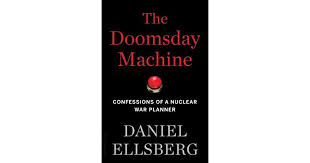But For the Grace of . . . .
Daniel Ellsberg is famous for leaking the Pentagon Papers to the New York Times. The papers, classified documents that showed that the US government was aware that the Vietnam War was not going well, redefined the public debate about the conflict and led to the prosecution of Ellsberg. He escaped conviction – the government broke many laws in its attempt to silence him – and he left government work to devote his life to political activism.
It was no accident that Ellsberg, a trusted civilian defense analyst in the 1960s, had access to sensitive material. He was a Marine who attended Harvard for his undergraduate and doctoral degrees. Ellsberg’s dissertation on decision theory raised issues that are still being studied to this day. His work for the RAND Corporation was very well-received. A smart and knowledgeable scholar, Ellsberg’s professional life developed at the intersection of ideas and defense policy.
 Ellsberg recently wrote The Doomsday Machine: Confessions of a Nuclear War Planner. A non-fiction autobiographical account of his work as a nuclear war strategist in the early part of his career, the book explains much of the thinking – or non-thinking – surrounding the development and potential deployment of the US nuclear arsenal. It is a book about organizational decision-making, politics and strategy. It is a sobering read. The Doomsday Machine is not the most up-to-date or comprehensive work about contemporary nuclear arms. It lacks current data, the big picture about how things have and have not changed over the past few decades, and efforts and stabilization. It does bring a personal touch to the madness, though, and make a compelling case for attention. With the recent nuclear false alarm in Hawaii on our screens and in our minds, coupled with the latest plans for loosening the potential use of nuclear weapons, the warnings in The Doomsday Machine seem all the more relevant.
Ellsberg recently wrote The Doomsday Machine: Confessions of a Nuclear War Planner. A non-fiction autobiographical account of his work as a nuclear war strategist in the early part of his career, the book explains much of the thinking – or non-thinking – surrounding the development and potential deployment of the US nuclear arsenal. It is a book about organizational decision-making, politics and strategy. It is a sobering read. The Doomsday Machine is not the most up-to-date or comprehensive work about contemporary nuclear arms. It lacks current data, the big picture about how things have and have not changed over the past few decades, and efforts and stabilization. It does bring a personal touch to the madness, though, and make a compelling case for attention. With the recent nuclear false alarm in Hawaii on our screens and in our minds, coupled with the latest plans for loosening the potential use of nuclear weapons, the warnings in The Doomsday Machine seem all the more relevant.
Some of the key points Ellsberg hammers home:
- There is no one nuclear “button.” In fact, the decision to use nuclear weapons is decentralized and at the discretion of military officials far down the organizational tree.
- Much US nuclear strategy is based on the assumption that the US would strike first.
- Much US nuclear strategy assumed that a nuclear conflict could only occur with the USSR and China – never just one of these countries. This was a problem for decades.
- As US nuclear planning became more sophisticated, anticipated casualties – which numbered in the hundreds of millions – grew to reflect the true consequences of a nuclear war.
- When Ellsberg first saw Stanley Kubrick’s apocalyptic satire, Dr. Strangelove, he considered it as accurate as a documentary.
Ellsberg’s proposals for a saner, slightly more safe future involve taking apart the doomsday machine (his term for this decentralized nuclear arsenal) include getting rid of the land based Intercontinental Ballistic Missiles (ICBMs), stop planning for strikes that target other country’s leaders (with no leader, there can be no surrender or de-escalation), and then promise never to use nuclear weapons. He notes that many times US presidents reference the potential use of nuclear weapons.
It is a scary problem to consider. We have more than enough nuclear weapons to make human life an impossibility and seemingly poor controls regarding their potential use. Ellsberg’s analysis of the Cuban Missile crisis highlights just how lucky we have been in avoiding nuclear conflict. Deterrence is poorly considered and something that needs a rethink. In fact, the broad question of nuclear strategy demands attention. Ellsberg’s book is a well-written and cogent warning about the state of the nuclear arsenal: who controls it, who thinks about it, and how it developed.
David Potash